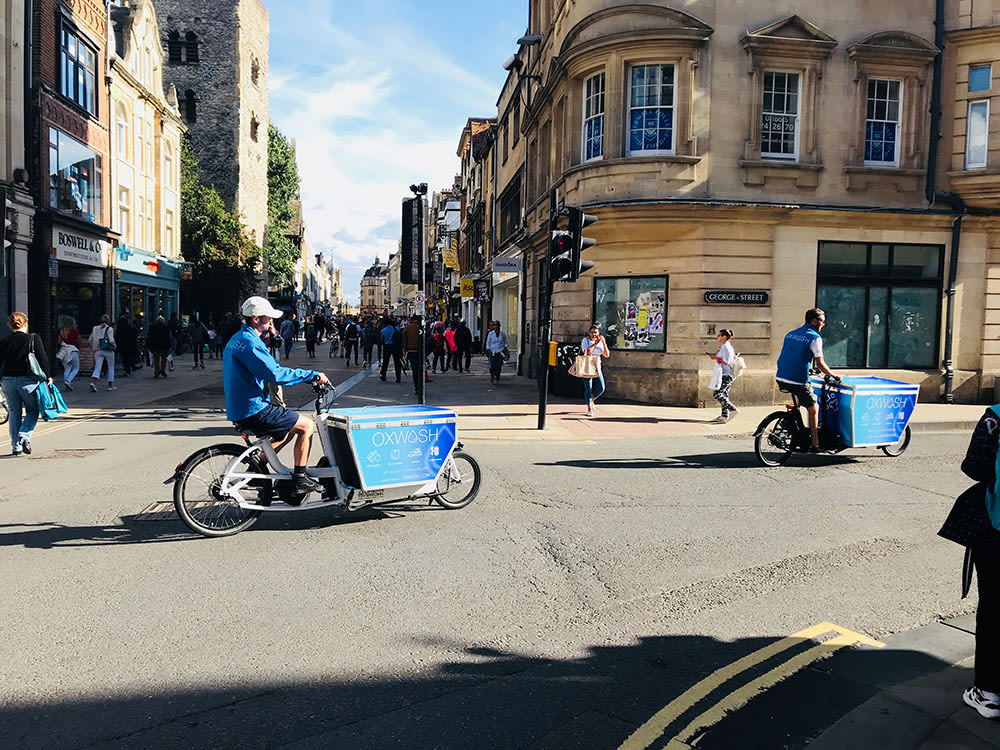Cycling in Oxford - A Look at Some Problems and Solutions


Business & Insights
Commuters whirring quietly into town on cycle paths that cut across green fields from the suburbs; tourists on dockless bikes winding through the tranquil alleyways lined in honeyed stone; students massing at the junctions, a gown or two flapping amongst them. In the popular imagination there is no doubt that Oxford is generally seen as a city cycle-friendly in both infrastructure and attitude, with a pre-automobile layout and large student population that should mean that cycling is popular and well catered-for. There is no doubt that there's some truth in this, but the reality of the situation is a more complex story of unrealised potential, competing interests and dysfunctional dialogue.
I write this the week after Jamie, one of our longest-serving, most reliable and most conscientious riders, was savagely attacked while delivering dry cleaning in Oxford by bike. Riding in a responsible manner along Beaumont St, Jamie was run into the gutter by a driver who then proceeded to shout at and threaten him and push his bike over. It is the courier's lot to pray each morning that such troglodytes will remain in their holes, but that day Jamie was not so lucky.
Incidents like this live long in the memory, and it only takes a hairy moment between two buses on St Aldates or negotiating the potholes on George St with a taxi behind you to set you on edge and change your perception of what cycling in Oxford is like for the worse. Cyclists, especially the less confident, remember the one car that cuts them up over the 99 that don’t - and this equally applies to drivers who encounter bad cyclists. On reflection though, the reality is that the cycling experience in Oxford is very mixed - we're lucky to have several very good cycle paths and off-road routes, but there is so much potential to improve not only cycling infrastructure across the city, but also our attitudes towards cycling and how we talk about and prioritise the issue.
As couriers on electric-assist bikes, our ideal route aligns quite closely with that of most commuters: the traffic-free cycle path that is either segregated from the road it follows, as on Marston Ferry Road, or that follows a different route altogether, like the Marston cycle path or the river and canal towpaths. Our priorities are simple: we need arterial routes that connect areas of the city and which offer continuous cycling without exposure to traffic. This is the ideal, but more specifically, we need to avoid spots that generate dangerous contact with traffic, such as the spots where cycle paths push cyclists suddenly back onto the carriageway, or where bike lanes exist but are not suitable for cycling, such as the potholed stretch west of the railway bridge on the Botley Road, where the bike path is less than one metre wide (the government's recommended width is 1.2-1.5m).
Most bike lanes in the city fall somewhere between these two poles. The key routes in and out of the city (The Abingdon, Banbury, Woodstock, Cowley, Iffley, Marston and Botley Roads) have bike lanes along the majority of their length, spaces where cyclists do not have to negotiate with cars for space in a single lane, and where the tarmac is of relatively good quality. This is definitely something to be commended, although it is worth noting that several of these sections of bike lane have been carved out of the pavement rather than the road, meaning that cyclists and pedestrians occupy a shared space. This type of bike lane, added to the road layout as an afterthought, often features trees, bus stops, and concealed driveways as obstacles - good examples are London Road in Headington and the upper section of Woodstock Road. Whilst this replaces one risk with another, it also adds subtly to the sense, felt by all, that cyclists do not deserve their own space and must live on the margins. It's this same mentality that the cyclist encounters daily on the roads and in the press, in the legions of drivers who think nothing of parking in a bike lane (e.g. Donnington bridge road, St Clements), in the bike boxes that I personally have rarely had the chance to stop in because they're usually occupied by a bus (e.g. George Street), in the foam-flecked rants about road tax and licensing, the ambivalence when the danger manifests in injury or worse.
We believe that although we're lucky to have a lot of good cycling infrastructure in Oxford, we believe that the real danger to cyclists comes at certain spots that have been poorly thought out. These may be more of a hazard for less confident cyclists or those who cannot maintain the same speed as the traffic. Examples abound of bike lanes that simply stop, like the one on the Iffley Road eastbound that forces cyclists to go around parking spaces into the main traffic stream, or the one at the eastern end of St Clements that brings cyclists off the road onto a bumpy footpath for no discernible reason, before tipping them straight back into the traffic stream just where it turns across the bike lane at the junction. One of the easiest problems to fix would be to stop vehicles parking in bike lanes, but there is no interest in tackling this issue. It would be unreasonable for cyclists to expect short-term solutions to all of these problems, but we feel that all too often that our perspective is not taken on road improvement issues. Oxfordshire County Council has recently released a cycling survey to assuage this concern, and if this proves to be a catalyst for improvement across the network, it will be a very welcome change.


Cyclists are often left to wonder, however, whether those who have designed the system and decided the priorities according to which it has been designed have directly experienced cycling in the city themselves, so glaring is the absence of a coherent vision for the network. It could be argued that such a masterplan would be impossible to implement, given that planners are working with tight space restrictions and a multitude of competing concerns, such as the buses of the admirable Park & Ride system. On the other hand, even the denotation or further separation from traffic of some key recommended routes between areas of the city would be an impactful first step. Ultimately, the council must consider more radical plans to put cycling at the heart of the transport strategy to complement their 2025 vision for a more pedestrianised city centre. For example, space could be created for segregated two-way bike paths by laying a one-way system over the paired main routes in and out of the city.
It is one thing to discuss changes to the infrastructure, but the bottom line for most cyclists who feel unsafe cycling around Oxford is that the threat comes not from lorries, buses and cars, but from their drivers. Real change will have been made in Oxford not only when more steps have been taken to separate motor vehicles from bicycles, but when cyclists and drivers alike feel that the roads can be used by all under a general consensus that they are to be shared according to our needs; when they can be used without aggression, frustration, and tribal rivalries, and when we feel that our lives are held in more than a callous disregard, or even contempt, by those who wield the ultimate power over them as they cruise disinterestedly in their boxes and gamble the lives of others. That is a cultural change, a shift to a state of mind that is the norm in those cities where building a safe and effective cycling infrastructure has also been a priority.
Related Articles


B Corp™ certified.


Surpassing NHS-grade disinfection.













